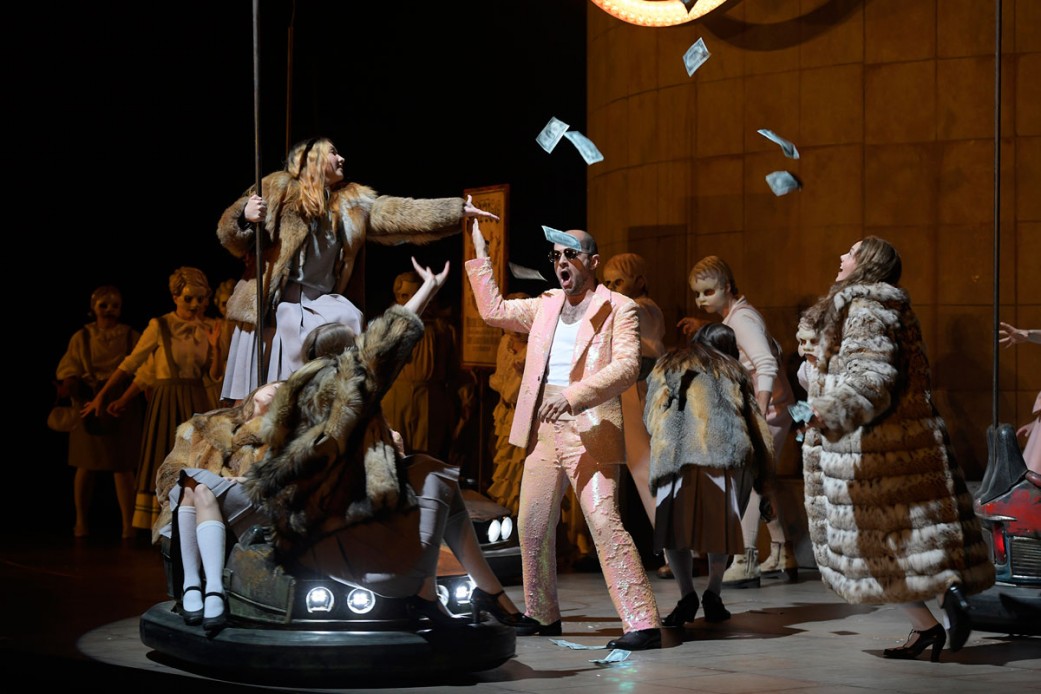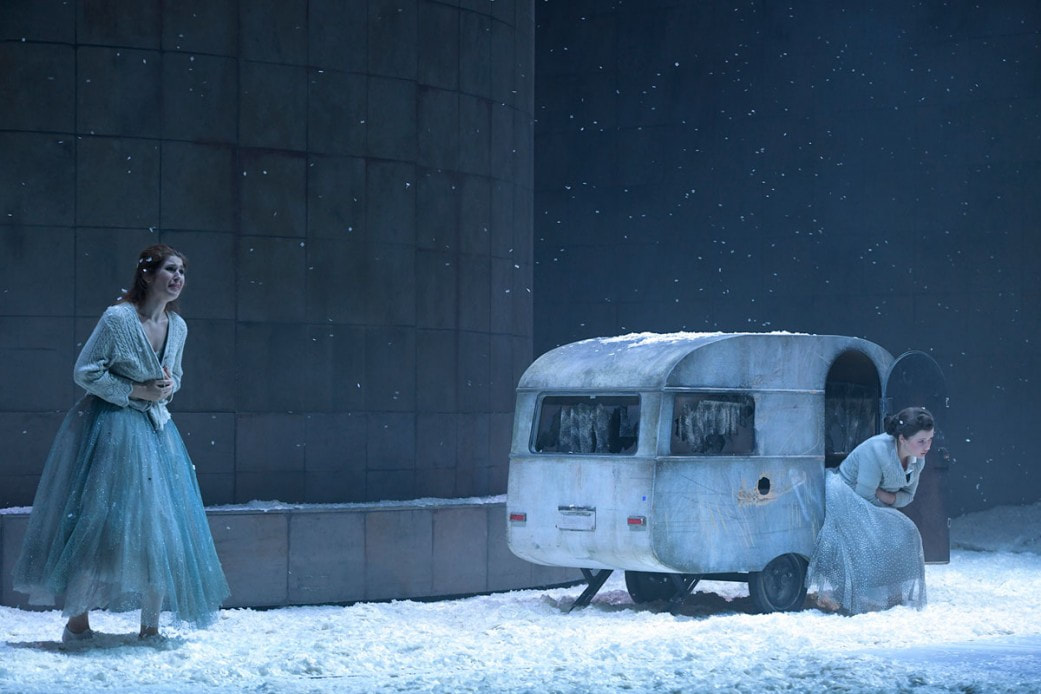A trip to Berlin. To the heart of the German (and European) canon with Gounod's Faust at Deutsche Oper. Berlin is a city with more history than might be good for a city. A city where the past weighs heavily on streetscape and conscience (Vergangenheitsbewältigung is a German word) but where the craters of world war bombs and communist demolition turn out to be a fertile soil for an unprecedented rich cultural life. Berlin, a city with many theatres, including three opera houses, with its different quarters, each with its own character and dynamics, is like a city that consists of many cities. My return to it, after a five-day visit, will only be a matter of time. 3 ... My visit started in the outskirts of the German capital. In Potsdam, where I attended a three hour Baroque opera: L' Europe Galante from André Campra. Four scenes about love, with accompanying heartbreak, situated in four different countries: France, Italy, Spain and Turkey. The 1697 opera-ballet was brought to the stage by the musicians, singers and dancers of Les Folies Françoises & Collegium Marianum Prague with passion and a great sense of theatre. An energetic performance that could not conceal the fact that Campra's music remained fairly uniform in all four parts. Add to this the fact that there was little or no dramatic arch and the decades that separate the piece from Gluck and Mozart (from operas with characters that are delicately refined by music and libretto) looked upon us, straight into our opera-loving faces. It was the subject that gave L' Europe Galante a topical touch, but further searching for extra layers or transcending thoughts proved futile. More than 300 years ago this singing and dancing piece served to entertain the aristocracy, a way to make it through a Sunday afternoon, and more than mundane entertainment for a, in this case, beautiful summer evening in Orangery Palace Sanssouci, it wasn't now either. ... 2 ... I continued my journey to the city where I visited - after the inevitable Frank Castorf deja-vu on Alexanderplatz and an excursion to the Dussman KulturKaufhaus where I once bought my first complete Ring des Nibelungen (Clemens Krauss & Karl Böhm in 1 purchase) - the Deutsche Oper Berlin. Here I attended Faust of Charles Gounod. In Goethe's version, Faust is a rustproof part of the German canon. Performed as a French Grand Opera on Berlin soil with upper titles in German and English, it could serve as an example of, as well as a pledge for, European integration. .. 1 Faust is a story about guilt, punishment and time. Time that, for ordinary mortals, is irreversible and almost always too short. (With the sudden death of Vinnie Paul - drummer of knuckle-sandwich-metal band Pantera - a few days earlier as a grim reminder of this.) To escape time and decay, a man in a late-life crisis sells his soul to the devil. In return he gets the body of his youth back and with it Marguerite. Director Philipp Stölzl places Marguerite at the heart of the story. We see the story unfold like a flashback from the women's prison where Marguerite, convicted for the murder of her baby, awaits her execution. We see the story pass us by, literally, against the backdrop of a large tower around which a plateau is turning. A rotating platform that provides scene changes with an open curtain. Faust exchanges the wheelchair in which he sits at the beginning for a bumby car from a fancy fair, his hospital clothes for those of a party animal, or pimp. He exchanges the prison of old age for the carnival of life and joins the party that Méphistophélès throws. He takes advantage of Marguerite only to leave her. In spite of everything, Marguerite continues to believe in his return and good intentions, but eventually kills her child in a nervous breakdown. More than guilty of murder, Stölzl sees Marguerite as a victim of circumstances and her ill-minded fellow human beings. People that hide their individuality, and lack of compassion, behind fish masks. A direct reference to the 'Fishfolk' from a poem by Bertold Brecht, about the German people in Nazi times. ACTION ! Philipp Stölzl is a film director - with Nordwand he introduced me to an unknown piece of German mountain climbing history - who explicitly seeks cinematic effects in this 19th century music drama. We see a use of slow motion from people who, eventually, freeze into mannequins, we see dolls in rotating tableau vivants. It produces beautiful images, but the tower and the rotating platform reduce the staging to a somewhat static whole as the opera progresses. It seems as if towards the end the direction has run out of ideas and with the repeatingly turning of the stage, the mise-en-scene has come to a standstill. A point of criticism also concerns the Personenregie that delivers some uncomfortable moments. Moments at which music and libretto try to connect in vain with the action on stage. When the women of Méphistophélès, a kind of Dracula's brides, attack Marguerite's brother, Valentin, the latter seems more interested in maintaining the hollow gesture of a Jesus Christ Pose than in defending himself. It is such a moment that the action is thwarted by symbolism. Perhaps explainable but a poor attempt to make action, text and music synchronize. The result is pretty stiff. ... AND CUT! Stölzl makes significant cuts in Gounod's opera, reduces it from five to four acts and takes out the ballet of the Walpurgis Night because it would serve the convention of the Grand Opera more than it would serve narrative purposes. A defensible choice that works well for this production. But also after these interventions it remains the case that the opera, after a smooth start with arias that serve the story, shifts to a story that is used to serve beautiful arias. Something in which this Wagnerian ears seem to hear some gratuitous vanity. It was the week of doppelgangers. Just like in Prokofiev's The Gambler a week earlier in Ghent, here too the main character looks back and sees itself as another person. Marguerite sees herself as a girl, with balloon and hammock chair emphasizing her innocence at the moment that Faust violates her. With this depiction of Marguerite as a child, the initial unscrupulousness of Faust, driven by carnal lusts, encouraged by Méphistophélès, is all the more inciting, and the contrast with the moment when Faust discovers that it is love what he really wants becomes only larger. Regret does not release Faust of his sins. His attempt to liberate Marguerite fails, she rejects the possibility to escape and Faust is left behind. He doesn't get redemption because the opera stops where the first book of Goethe's Faust ends. (Forgiveness for his sins and reunification with Marguerite - at the end of the second book - are not granted to Faust here. For the opera version of that we have to go to Boito's Mephistopheles.) Marguerite dies guided by a choir of angles. A singing to make clear that she is redeemed in death. Although the latter is questionable. The angelic singing that reflects salvation can also be interpreted as something that only sounds in Marguerite's head, like a final convulsion, a glance into the tunnel with light on the other end. It is an interpretation that is in line with the fact that Goethe was not a Christian but rather a freethinker who did not want his mind to be framed by religious dogmas. Philipp Stölzl focuses on the role of Marguerite and it is Nicole Car who does justice to the fate of the unfortunate maid. In Car's interpretation Marguerite's desire and suffering become a balm for the soul. Charles Castronovo is fine as Faust, both in voice and appearance, it is a role that is a personal favorite of his. Siebel, Marguerite's would-be lover, levels with his subject of admiration when it comes to sadness. It is a trouser role, a woman playing a men's role, beautifully and sensitively sung by mezzo soprano Vasilisa Berzhanskaya. Amidst this parade of characters who suffer to a greater or lesser extent from sadness, it is the villain who eventually is the most fun. In this, Grand Opera does not differ from, say, Star Wars and Italian bass-baritone Alex Esposito seems to understand this very well. He has visible joy in his role as Méphistophélès and does the work of the devil with the contagiousness of the mischief of a boy. The opera of Gounod, who got acquainted with Goethe's Faust in French (the man did not speak one word German), is given a staging in which the Grand Opera has to subordinate to the narrative. It results in a slimmed-down Faust, call it austere (the Walpurgis Night ballet will be missed by those who see theatrical excess as a source of entertainment rather than distraction). It is a Faust that, in its economic use of resources, still does justice to Gounod while it explicitly points to the source material: the poem, and its writer, on which Gounod based his opera. Deutsche Oper Berlin, 26 June 2018 Dates: 23 June - 6 July 2018 Conductor: Jacques Lacombe Orchester der Deutschen Oper Berlin Chor der Deutschen Oper Berlin Director: Philipp Stölzl Co-Regie: Mara Kurotschka Design: Philipp Stölzl & Heike Vollmer Faust: Charles Castronovo Méphistophélès: Alex Esposito Marguerite: Nicole Car Valentin: Thomas Lehman Siebel: Vasilisa Berzhanskaya - Wouter de Moor
0 Comments
Leave a Reply. |
TIMELINE
July 2024
|



 RSS Feed
RSS Feed